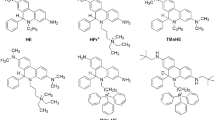Abstract
Quin2, a fluorescent calcium probe, has a low affinity for calcium in comparison to its affinities for transition metal ions. Chelation of ferric ion with quin2 strongly enhanced the formation of oxidizing species in the presence of bolus H2O2 as detected with four assays, electron spin resonance with the spin-trap DMPO, the deoxyribose assay, the DMSO assay, and plasmid DNA strand breakage. In comparison, Fe(III)-EDTA reacted with bolus H2O2 only as detected with electron spin resonance and the deoxyribose assay, but not as detected with the two latter assays. The addition of reductants, like ascorbate or superoxide generated by hypoxanthine/xanthine oxidase, to Fe(III)-EDTA in the presence of H2O2 produced plasmid DNA strand breakage and strong reactivity in both the DMSO and the deoxyribose assays. Our findings suggest that the main oxidizing species produced in Fenton-type reactions is hydroxyl radical. However, the reaction between Fe(III)-EDTA and bolus H2O2 appears to be exceptional and dominated by a nonhydroxyl radical species.
Similar content being viewed by others
References
R. Y. Tsien, T. Pozzan, and T. J. Rink,J. Cell Biol. 94, 325 (1982).
B. E. Sandström, M. Grandström, and S. L. Marklund,Free Rad. Biol. Med. 16, 177 (1994).
T. R. Hesketh, G. A. Smith, J. P. Moore, M. V. Taylor, and J. C. Metcalfe,J. Biol. Chem. 258, 4876 (1983).
O. Cantoni, P. Sestili, F. Cattabeni, G. Bellomo, S. Pou, M. Cohen, and P. Cerutti,Eur. J. Biochem. 182, 209 (1989).
B. Halliwell, and J. M. C. Gutteridge,FEBS Lett. 128, 347 (1981).
C. F. Babbs, and M. J. Gale,Anal. Biochem. 163, 67 (1987).
M. C. R. Symons, inElectron Spin Resonance, vol. 12B, M. C. R. Symons ed., Royal Soc. Chem., London, UK, pp. 191–238 (1991).
O. I. Aruoma, B. Halliwell, and M. Dizdaroglu,J. Biol. Chem. 264, 13024 (1989).
O. I. Aruoma, B. Halliwell, E. Gajewski, and M. Dizdaroglu,J. Biol. Chem. 264, 20509 (1989).
M. Dizdaroglu, G. Rao, B. Halliwell, and E. Gajewski,Arch. Biochem. Biophys. 285, 317 (1991).
J. D. Rush, and W. H. Koppenol,J. Biol. Chem. 261, 6730 (1986).
Author information
Authors and Affiliations
Rights and permissions
About this article
Cite this article
Sandström, B.E., Granström, M., Vezin, H. et al. A comparison of four assays detecting oxidizing species. Biol Trace Elem Res 47, 29–36 (1995). https://doi.org/10.1007/BF02790098
Issue Date:
DOI: https://doi.org/10.1007/BF02790098




